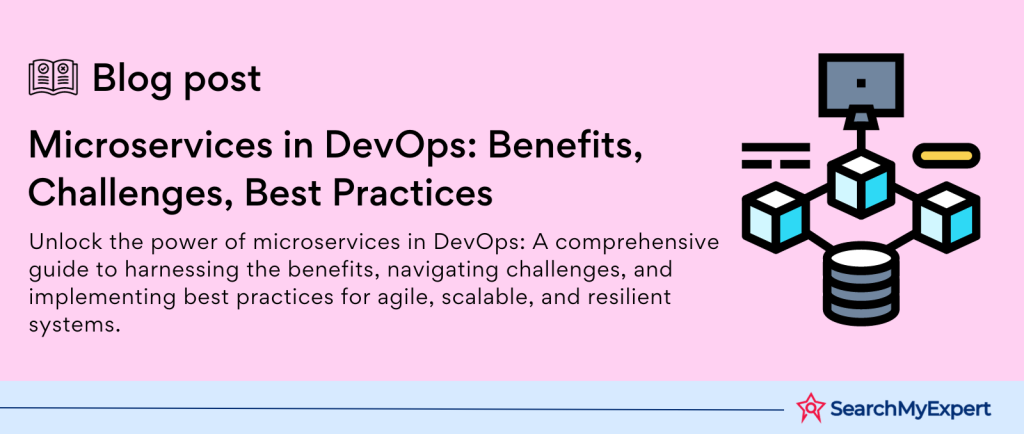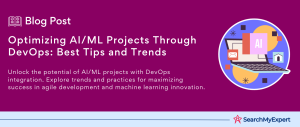Microservices Architecture in DevOps
In the fast-paced world of software development, the need for agility, scalability, and efficiency has led to the evolution of Microservices Architecture and DevOps practices. In this article, we’ll delve into the realm of Microservices Architecture in DevOps, understanding what they are and how they address the challenges posed by monolithic applications.
Let’s Dive In
Microservices Architecture, often simply referred to as Microservices, is an architectural style for designing software systems where applications are composed of small, independent, and loosely coupled services. Each service is responsible for a specific piece of functionality, can be developed and deployed independently, and communicates with others through well-defined APIs. In essence, Microservices break down a monolithic application into smaller, more manageable parts.
On the other hand, DevOps is a set of practices and cultural philosophies that promote collaboration and communication between Development (Dev) and IT Operations (Ops) teams. It aims to automate and streamline the software delivery and infrastructure management processes, ensuring a continuous and reliable delivery pipeline.
The Monolithic Challenge
Before we dive deeper into Microservices and DevOps, it’s crucial to understand the challenges posed by monolithic applications. Monolithic applications are characterized by a single, large codebase where all components and functionalities are tightly coupled. While this approach may be suitable for smaller projects, it becomes problematic as applications grow in complexity and scale.
Some of the main challenges of monolithic applications:
- Scalability Issues:
Monoliths are challenging to scale efficiently. You often have to scale the entire application, even if only a small part of it needs more resources. - Slow Development: Large codebases can lead to slower development cycles. Developers might be stepping on each other’s toes, making it difficult to work collaboratively.
- Limited Technology Stack:
Monolithic applications are often tied to a specific technology stack, making it challenging to adopt new technologies or languages. - Difficulty in Maintenance: Maintaining monolithic applications can be a daunting task. A change in one part of the code can have unintended consequences in other areas.
- Deployment Bottlenecks:
Deploying updates or new features can be risky and time-consuming. It often requires taking the entire application offline during deployment.
Microservices to the Rescue
Microservices Architecture offers a compelling solution to the challenges posed by monolithic applications. Here’s how:
- Scalability: Microservices allow you to scale individual services independently. This means you can allocate resources where they are needed most, improving efficiency and cost-effectiveness.
- Faster Development:
Smaller, independent teams can work on individual microservices. This reduces development bottlenecks and allows for faster feature delivery. - Diverse Technology Stack:
Microservices can use different technology stacks and programming languages, enabling you to choose the right tools for each specific service. - Easier Maintenance:
With each service having its own codebase, maintenance becomes more manageable. Changes and updates can be made without affecting the entire application. - Continuous Deployment: Microservices encourage a DevOps culture, enabling continuous integration and continuous deployment (CI/CD) pipelines. This results in faster and more reliable software releases.
Key Principles of Microservices Architecture
Microservices Architecture is built on a set of key principles that enable the development of scalable, flexible, and efficient software systems. In this step, we’ll explore these fundamental principles that underpin the world of Microservices.
Loose Coupling and Independence
At the heart of Microservices Architecture is the concept of loose coupling and independence. This principle emphasizes that each microservice should be self-contained and have minimal dependencies on other services. Here’s how it works:
- Self-Containment:
Each microservice encapsulates a specific piece of functionality, such as user authentication or product catalog. It contains its own codebase, data storage, and even its own database if necessary. - Well-Defined APIs: Microservices communicate with each other through well-defined APIs (Application Programming Interfaces). These APIs act as contracts, specifying how services interact. By adhering to these contracts, services can work together seamlessly while remaining independent.
- Isolation: If one microservice encounters an issue or needs an update, it can be modified without affecting other services. This isolation reduces the risk of cascading failures and allows for faster development cycles.
Decentralized Governance
Microservices promote decentralized governance, which means that each microservice is owned and developed by a separate team or individual. Here’s how this principle plays out:
- Autonomous Ownership:
Each microservice team has full ownership and autonomy over their service. They are responsible for its development, maintenance, and scalability. - Small Teams: Smaller teams can work more efficiently, make quicker decisions, and have a deep understanding of their microservice’s domain.
- Rapid Iteration:
Decentralized governance enables rapid iteration and innovation. Teams can respond to changing requirements or market demands without waiting for coordination with other teams.
Technology Agnosticism
Microservices embrace technology agnosticism, allowing you to choose different technologies and programming languages for different services. Here’s why this principle is essential:
- Freedom to Choose: Developers can select the best tools for the job. For example, a microservice handling real-time data might use Node.js, while another focused on data analysis might use Python.
- Avoid One-Size-Fits-All:
Monolithic applications often force a one-size-fits-all technology stack. Microservices empower you to tailor the technology stack to each service’s specific needs. - Reduced Vendor Lock-In:
By not being tied to a single technology stack, you reduce the risk of vendor lock-in, giving you more flexibility in the long term.
Continuous Integration and Delivery (CI/CD)
Automation is at the core of Microservices Architecture, particularly when it comes to Continuous Integration and Continuous Delivery (CI/CD). Here’s how automation plays a crucial role:
- CI/CD Pipelines:
Microservices teams implement CI/CD pipelines to automate testing, integration, and deployment processes. This automation ensures that changes can be quickly and reliably pushed to production. - Faster Releases: CI/CD enables frequent and smaller releases, reducing the risk and impact of deployment failures. This aligns with the goal of delivering new features and improvements rapidly.
- Feedback Loop:
Automated testing and monitoring provide a continuous feedback loop. Teams can detect issues early in the development process, making it easier to address them before they reach production.
Benefits of Microservices in DevOps
Microservices Architecture in DevOps brings a multitude of benefits that revolutionize the way software is developed, deployed, and maintained. In this step, we’ll explore the advantages that organizations can harness when they embrace Microservices.
Increased Agility and Innovation
- Faster Development Cycles: With Microservices, development cycles become more rapid. Smaller, independent teams can work on individual services concurrently, reducing bottlenecks and accelerating the delivery of new features.
- Easier Experimentation: Microservices encourage experimentation and innovation. Teams can test new ideas or improvements in isolation without risking the stability of the entire application.
- Quicker Updates: Microservices allow for incremental updates. Instead of waiting for a monolithic release, changes can be deployed as soon as they are ready. This agility enables organizations to respond swiftly to market demands.
Improved Scalability and Reliability
- Independent Scaling: Each microservice can be scaled independently based on its specific needs. This means that services experiencing high traffic or demand can be allocated more resources without affecting others, resulting in better performance and fault tolerance.
- Isolation for Resilience: In the event of a failure in one microservice, it doesn’t necessarily bring down the entire application. Isolation of services ensures that failures are contained, allowing the system to remain operational.
- Load Balancing: Microservices make it easier to implement load balancing strategies, distributing incoming requests evenly among multiple instances of a service. This optimizes resource utilization and ensures a smoother user experience.
Enhanced Team Collaboration and Ownership
- Smaller, Focused Teams: Decentralized ownership of microservices means smaller, more focused teams. This fosters better communication and collaboration, as team members have a deep understanding of their microservice’s domain.
- Accountability:
Team members take full ownership of their microservices, from development to maintenance. This sense of ownership leads to increased accountability and a stronger commitment to the service’s success. - Cross-Functional Teams:
Teams often consist of members with diverse skill sets, including developers, testers, and operations specialists. This cross-functional approach ensures that all aspects of a service are well-managed.
Simplified Operations and Maintenance
- Easier Debugging:
Isolated microservices simplify debugging and troubleshooting. When an issue arises, it can be pinpointed to a specific service, making it easier to identify and fix problems. - Rollbacks and Upgrades: Microservices allow for safer rollbacks and upgrades. If a new version of a service introduces issues, it can be rolled back without affecting the entire application. This minimizes downtime and user disruption.
- Efficient Resource Utilization:
Microservices enable efficient use of resources. Services can be deployed on the most suitable infrastructure, whether it’s on-premises or in the cloud, optimizing resource utilization and cost-effectiveness.
Challenges of Microservices Architecture
While Microservices Architecture offers numerous benefits, it’s not without its share of challenges. In this step, we’ll dive into the key challenges organizations may encounter when adopting Microservices.
Increased Complexity
- Robust Monitoring: Microservices introduce complexity in the form of numerous interconnected services. Robust monitoring and observability tools are essential to gain insights into the health and performance of each service. This includes tracking metrics, logs, and distributed tracing to identify bottlenecks and troubleshoot issues effectively.
- Distributed Tracing:
In a microservices environment, requests often span multiple services. Distributed tracing becomes crucial for understanding the flow of requests across services, allowing for comprehensive performance analysis and debugging.
Testing and Debugging Challenges
- Interconnected Services:
Testing microservices can be challenging due to the interdependencies between services. Ensuring that changes in one service do not break the functionality of others requires comprehensive integration testing. - Troubleshooting Distributed Systems: Debugging distributed systems can be complex. Identifying the source of an issue that spans multiple services requires specialized skills and tools. Service mesh solutions and distributed tracing can aid in troubleshooting.
Infrastructure and Operational Overhead
- Containerization:
Microservices are often deployed in containers to ensure consistency across different environments. Managing containerization and container orchestration platforms like Kubernetes adds operational overhead. - Service Discovery:
In a microservices ecosystem, services need to discover and communicate with each other dynamically. Service discovery and API management tools are necessary to facilitate this, but they also introduce complexity. - Scaling Challenges:
While independent scaling is an advantage, it can also be challenging to manage. Organizations must implement auto-scaling strategies and ensure that services can handle sudden spikes in traffic.
Talent and Organizational Changes
- Mindset Shift:
Adopting Microservices requires a shift in mindset from monolithic development to distributed systems thinking. Developers need to understand the intricacies of managing services independently. - Skills Gap: Building and maintaining microservices demand a specific skill set, including knowledge of containerization, orchestration, and cloud-native technologies. Organizations may need to invest in training or hire experts in these areas.
- Organizational Alignment:
Siloed development and operations teams may need to reorganize into cross-functional teams that take end-to-end ownership of microservices. This alignment can be challenging but is vital for success.
Best Practices for Implementing Microservices in DevOps
Implementing Microservices in a DevOps environment requires a strategic approach to reap the full benefits of this architectural style. In this step, we’ll explore best practices that organizations can follow to successfully adopt Microservices.
Start Small and Evolve
- Begin with Simplicity:
Start with a few simple microservices to gain experience and confidence. This allows teams to learn the intricacies of Microservices Architecture without overwhelming complexity. - Incremental Growth:
As your organization becomes more comfortable with Microservices, gradually increase the complexity and number of services. This incremental approach ensures that you can manage and scale effectively.
Focus on Business Capabilities
- Business Alignment: Align microservices with clear business capabilities and functions. Each microservice should deliver value to the business and represent a distinct piece of functionality, such as user management or product catalog.
- Domain-Driven Design:
Adopt domain-driven design principles to model microservices around specific business domains. This approach ensures that services are closely tied to the business’s needs.
Design Effective APIs
- Well-Documented APIs: Create clear, well-documented APIs for each microservice. Documentation is crucial for enabling other teams to understand how to interact with your service.
- Versioning: Implement versioning for APIs to ensure backward compatibility. This allows other services to continue functioning even as your service evolves.
- Backward Compatibility:
When making changes to APIs, strive to maintain backward compatibility whenever possible. This minimizes disruptions for services that rely on your API.
Automate Everything
- CI/CD Pipelines: Leverage Continuous Integration and Continuous Delivery (CI/CD) pipelines for automation. Automate the deployment, testing, and monitoring processes to ensure consistent and reliable releases.
- Infrastructure as Code:
Use Infrastructure as Code (IaC) to automate the provisioning of infrastructure and environments. Tools like Terraform and Ansible can help manage infrastructure changes.
Monitor and Observe
- Comprehensive Monitoring: Implement comprehensive monitoring and observability systems. Monitor key metrics, logs, and traces to proactively identify issues and bottlenecks.
- Distributed Tracing:
Implement distributed tracing to gain insights into how requests flow across microservices. This helps troubleshoot performance issues and trace the root causes of problems. - Automated Alerts: Set up automated alerts based on predefined thresholds. When anomalies or issues are detected, alerts should notify the appropriate teams for swift action.
Tools and Technologies for Microservices in DevOps
Implementing Microservices in a DevOps environment requires the use of specific tools and technologies to streamline development, deployment, and maintenance processes. In this step, we’ll explore some of the essential tools and technologies that support Microservices in DevOps.
Containerization Platforms
- Docker:
Docker is a popular containerization platform that allows you to package applications and their dependencies into containers. Containers provide consistency and portability, making it easier to deploy and manage microservices across different environments. - Kubernetes:
Kubernetes is an orchestration platform for containerized applications. It automates container deployment, scaling, and management. Kubernetes is valuable for orchestrating microservices in a dynamic and scalable way.
API Gateways and Management Tools
- NGINX: NGINX is often used as an API gateway and reverse proxy. It provides load balancing, routing, and security features, making it an essential component for managing API traffic.
- Apigee:
Google’s Apigee is an API management platform that helps organizations design, secure, and analyze APIs. It offers features for authentication, traffic management, and analytics.
Service Discovery and Registry Services
- Consul:
HashiCorp’s Consul is a service discovery and service mesh solution. It helps microservices locate and communicate with each other dynamically, ensuring that services can discover and connect to one another as they scale. - Eureka: Netflix’s Eureka is a service registry tool that enables microservices to register themselves and discover other services. It’s commonly used in Spring Boot applications.
Configuration Management Tools
- Consul KV: In addition to its service discovery capabilities, Consul also provides a key-value store for configuration management. Microservices can retrieve configuration settings from Consul, allowing for dynamic configuration changes.
- Spring Cloud Config: Spring Cloud Config is a configuration management tool that integrates with Spring Boot applications. It centralizes configuration management and supports versioning and environment-specific configurations.
Monitoring and Observability Tools
- Prometheus:
Prometheus is an open-source monitoring and alerting toolkit. It collects metrics from various services and applications, helping organizations gain insights into the performance of their microservices. - Grafana: Grafana is often used in conjunction with Prometheus for visualization and dashboards. It provides a user-friendly interface to create custom monitoring dashboards.
- Jaeger:
Jaeger is a distributed tracing system that helps teams trace requests as they flow through microservices. It aids in identifying performance bottlenecks and troubleshooting issues in a distributed architecture.
These tools and technologies are essential components of a Microservices Architecture in a DevOps context. They enable organizations to manage the complexities of microservices effectively, from containerization and API management to service discovery, configuration, and monitoring.
Key Takeaways
Let’s summarize the key takeaways and potential of Microservices for DevOps:
- Agility and Innovation:
Microservices enable faster development cycles, easier experimentation, and quicker updates. This agility allows organizations to respond swiftly to market demands and innovate at a rapid pace. - Scalability and Reliability:
Individual microservices can be scaled independently, improving performance and fault tolerance. The isolation of services ensures that failures are contained, enhancing system reliability. - Team Collaboration and Ownership:
Smaller, focused teams with autonomy over their microservices foster efficient collaboration and accountability. Cross-functional teams contribute to a holistic approach to service ownership. - Simplified Operations:
Microservices simplify debugging, rollbacks, and upgrades due to service isolation. Infrastructure automation and efficient resource utilization reduce operational overhead.
Potential of Microservices for DevOps
The potential of Microservices in DevOps is vast. Organizations that adopt this architectural style can:
- Deliver High-Quality Software: Microservices allow for continuous integration and delivery, resulting in high-quality software releases with reduced risk.
- Adapt to Change:
Microservices adapt to evolving business needs, making it easier to add new features or modify existing ones without major disruptions. - Scale Efficiently:
With independent scaling of microservices, organizations can efficiently allocate resources to meet varying levels of demand. - Improve Resilience:
Isolation and redundancy in microservices improve system resilience,
ensuring that failures in one service do not cascade to others. - Enhance User Experience: Load balancing and efficient resource utilization contribute to a better user experience by ensuring consistent performance.
Recommendations for Further Learning and Resources
To further explore Microservices in DevOps, consider the following recommendations:
- Online Courses: Enroll in online courses or certifications that cover Microservices, DevOps practices, and related technologies. Platforms like Coursera, edX, and Udacity offer relevant courses.
- Books: Read books on Microservices and DevOps, such as “Microservices Patterns” by Chris Richardson and “The Phoenix Project” by Gene Kim, Jez Humble, and Kevin Behr.
- Community Engagement:
Join online communities and forums related to Microservices and DevOps. Participating in discussions and sharing experiences can provide valuable insights. - Practical Projects: Work on practical projects that involve building and deploying microservices. Hands-on experience is invaluable for mastering these concepts.
- Documentation and Guides: Explore documentation and guides provided by Microservices and DevOps tool providers. These resources often include tutorials and best practices.
- Conferences and Webinars:
Attend industry conferences, webinars, and meetups focused on Microservices and DevOps. These events offer opportunities for networking and learning from experts.
Conclusion
Microservices Architecture in DevOps is a transformative approach to building and managing software systems. It offers a range of benefits that empower organizations to thrive in today’s fast-paced technology landscape.
Remember to regularly update your knowledge as these fields continue to evolve. By embracing Microservices in DevOps, organizations can position themselves for success in the ever-changing world of software development.
Unlock agility and efficiency with top-tier DevOps Service Agencies.
Table of Contents
Toggle






